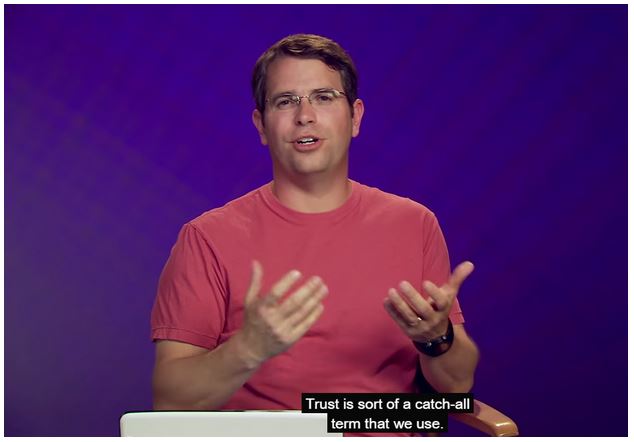90 Digital CEO Nick Garner explains that there is no such thing as trust rank in this edition of CalvinAyre.com’s SEO Tip of the Week.
A refresher on theme for this series of articles.
Because link acquisition is becoming less and less important these days, there is another factor which is filling the vacuum: engagement rank. Engagement rank is the part of the Google algorithm which affects search results through user engagement. To improve user engagement, there is a process and it’s called trust optimisation. Along with on-site optimisation, link acquisition, there is now trust optimisation which helps you improve your engagement rank. On to the article!
TrustRank is one of those urban myths which has persisted for years amongst the SEO community. Many people still believe TrustRank is a PageRank derivative which affects rankings.
The theory behind TrustRank is that good websites link to other good websites, therefore you might have a seed set of websites and from that they link to other sites and those links to other sites and so on. The closer you are to these seed sites, the more TrustRank you get.

However, TrustRank was actually originated by three people, none working at Google: Zoltan Gyongyi and Hector Garcia-Molina of Stanford University and Jan Pedersen of Yahoo!.
In reality Google doesn’t have something as simple as TrustRank. If you use Google quality rater guidelines as a basis for how Google decide whether a site is trusted or not, you can see it’s actually a whole basket of different pieces which all add up together
Matt Cutts explained how Google sees trust…

Video Link : https://www.youtube.com/watch?v=ALzSUeekQ2Q
Transcription:
“Today’s question comes from Canada. And the question is from JZ Becker, who wants to know:
Can you talk a bit about ranking signals like trust? We hear these mentioned from time to time by Googlers, but there’s no official documentation available from Google on the topic. ?
Trust is sort of a catch-all term that we use. So PageRank is the most well known type of trust. It’s looking at links and how important those links are. So if you have a lot of very high quality links, then you tend to earn a lot of trust with Google. There’s other signals. There’s over 200 different signals that we use in our ranking. But you can kind of break them down into this notion of sort of trust and how well you match a particular query.
So how topical you are. What’s your information retrieval score? Just on the merits of what the user typed in. PageRank is one of these trust-type algorithms that’s trying to figure out–we use several words–reputation, trust, authority.
And it’s not that we have something specifically called TrustRank, or we have something specifically called authority rank, or something like that. We’re basically just trying to say, in the general scheme of things, how much reputation, or how much are we willing to believe that this is a high quality page, or a high quality site? Those sorts of things.
So in general, what you want to have is a very reputable site. But you also want to have a site that’s about, or a page that’s about, the topic that the user typed in. So in an ideal world, you’ve got both. It’s very high on the reputation scale, but it’s also exactly what the user was looking for in terms of typing in and finding a match for what they were typing. So we use a lot of different words like trust, reputation, authority. And PageRank is a specific example of those sorts of things.
But we mean it in a more general sense. It’s not, typically, a specific algorithm. It’s just trying to figure out how much– if a regular user saw this, maybe without even seeing a query at all– how much would they consider it a high quality page? How much would they consider it really useful, as far as being able to answer whatever questions that particular site was about? Hope that helps.”
My view on the important components in ‘trust’
My view is that the largest part is what I call engagement rank, which is simply click through rates from search result pages through to given websites and then the amount of dwell time on those sites.
If you look at Webmaster tools, Google give you a really helpful breakdown of keywords and click through rates per phrase. It’s clear Google are prioritising this, and I’ve seen it from personal experience when we’ve experimented with crowd sourced click through rate activities.
The idea being, you build trust over time and once you have it everything you do will be more welcome by Google than before.
When you look at Google quality rater guidelines, in aggregate there are a huge number of trust signals going from citations on third-party websites, through to genuine contact information and going through to consistent WHOIS information.
Interestingly, majestic have come up with something called trust flow, which is their version of TrustRank. The odd thing about trust flow is how accurate it is. It correlates extraordinarily well with the rankings. In other words if a website has a trust flow of between 15 and 25, for the sub domain, it is 70% likely to rank. As trust flow increases, so does the likelihood of ranking.
Conclusion
my main point is that it’s easy to oversimplify what Google does. It would be lovely to think there is such a thing as TrustRank with Google, and all you need to do is just get better links. But the truth is were getting into an era of the good sites winning because Google is beginning to rely on so many more things than just links.

Nick Garner is founder of 90 Digital, the well-known and respected iGaming search marketing agency.
Nick is obsessed with SEO and whatever it takes to rank sustainably on Google.
